RBA Annual Conference – 1989 Changes in the Behaviour of Banks and Their Implications for Financial Aggregates Ric Battellino and Nola McMillan[*]
Abstract
The focus of this paper is the way banks have changed their behaviour as a result of the process of deregulation that began in the 1970s and accelerated in the 1980s. The principal theme of the paper is the shift from asset management to liability management that accompanied deregulation. This change in particular has had implications for the behaviour and interpretation of financial aggregates. The paper is largely historical but includes some comments on recent changes, including to SRD arrangements.
1. Introduction
This paper looks at the way the behaviour of banks has changed as a result of deregulation, and the effect this has had on financial aggregates. It complements an earlier paper by Bullock, Morris and Stevens (1989), which noted that there have been substantial changes over the past twenty years in the relationships between financial aggregates and economic activity.
While the effects of deregulation have been most pronounced in the past few years, important steps towards deregulation were taken as early as 1973 when the interest rate ceiling on bank certificates of deposit (CDs) was removed. This began the process of giving banks greater control over the interest rates they paid on deposits and opened the way for the change from asset management to liability management. The move to liability management by banks was arguably the single most important factor causing the behaviour of financial aggregates to change. It is discussed in detail in Section 2 of this paper.
Other major steps in the deregulatory process were the removal of the remaining interest rate ceilings on bank deposits, the removal of exchange controls, the floating of the exchange rate, the entry of banks into the market for overnight funds, and the establishment of new banks. These steps, which took place in the period 1980 to 1985, saw further substantial changes in the behaviour of banks, in the market shares of banks and other financial intermediaries, and in the overall amount of intermediation. These issues are discussed in Section 3.
Section 4 goes on to look at the way financial intermediaries reacted to the remaining controls – in particular, at the way in which they altered their funding patterns in an attempt to avoid the costs of Statutory Reserve Deposits (SRDs). Recent developments, following the replacement of SRDs by non-callable deposits, are also briefly discussed. The major changes in regulations over the past twenty years are listed in the Appendix.
2. Removal of Interest Rate Controls and the Shift to Liability Management
(a) Interest Rate Controls and Asset Management
Up to the early 1970s, there were controls on the interest rates banks could pay on deposits, on the interest rates they could charge on loans, and on the maturity of deposits they could raise. (See the Appendix for a description of controls in force at that time.) In these circumstances, banks behaved largely as asset managers. They accepted passively whatever deposits came their way, since controls over interest rates limited their scope to go out into the market and compete for deposits. They then decided how to allocate these funds among various assets.
On the asset side of their balance sheets, banks adjusted to short run changes in inflows of deposits by movements in their holdings of liquid assets and Commonwealth Government securities (LGS).[1] During times of large inflows of deposits, LGS assets were run up and, when deposit inflows slowed or outflows occurred, LGS assets were run down. On average, banks held a large buffer of LGS in excess of minimum requirements.[2]
Fluctuations in holdings of LGS helped to shield advances from variations in deposit flows. However, in the event of a tightening in financial conditions, banks eventually were forced to adjust their advances, as they could not competitively bid for deposits to replenish their liquid assets. Credit rationing on a non-price basis was an important part of the adjustment process.
In these circumstances, a tightening of policy tended to have a substantial and relatively fast effect on the growth of bank deposits. There were two main channels through which policy could be tightened. One was the LGS/SRD mechanism. By raising the SRD ratio, banks could be forced to cut back on holdings of other assets. In the short run, this usually involved relinquishing LGS but if this brought them close to the minimum LGS ratio, they would be forced to restrain lending. This in turn restrained deposits. Alternatively, policy could be tightened by more active sales of CGS (including issues of Australian Savings Bonds). This forced up interest rates, not only on CGS but also more generally. To the extent that sales were to non-banks, it also directly attracted deposits out of the banking system as non-banks paid for their securities. Banks were restricted in their ability to compete for deposits because of controls over the interest rates they could pay.
Graph 1 illustrates the above adjustment process by reference to the late 1960s and the first half of the 1970s, a period during which banks behaved overwhelmingly as asset managers.[3] While interest rates on CDs were freed in 1973, banks did not move immediately to make full use of this freedom; it took some time to adapt behaviour, and the CD market initially was not very big. It was not until the second half of the 1970s that clearer signs of liability management began to emerge.
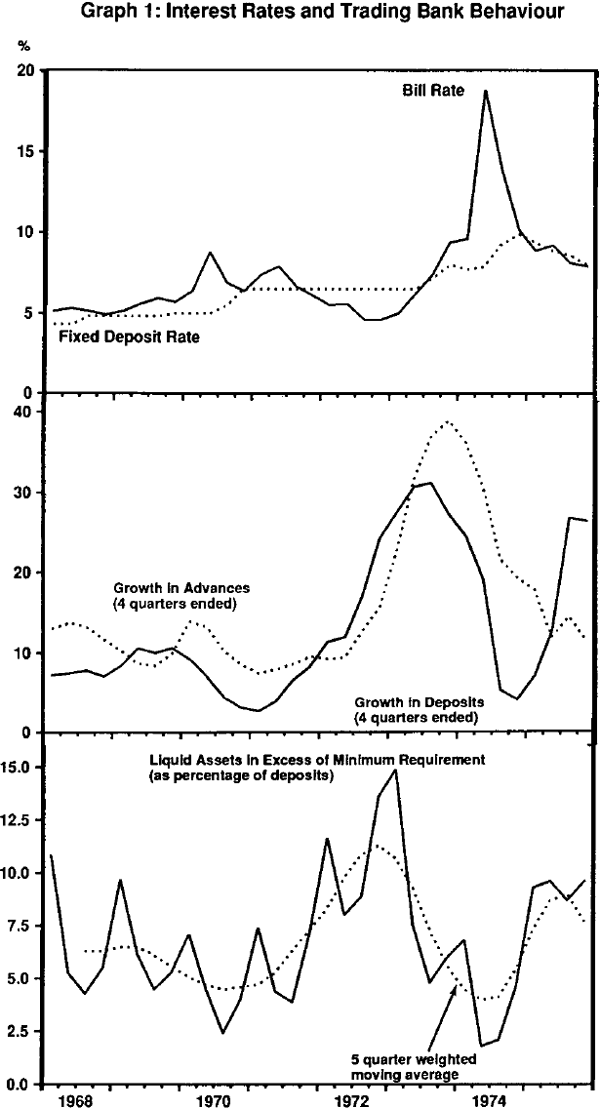
The top panel of the graph shows two interest rates: the 90-day bank bill yield (as an indicator of market rates), and the interest rate on trading bank fixed deposits. The graph covers two periods of policy tightening, 1970 and 1974. In the first period, the bank bill rate rose by about 4 percentage points, but the interest rate on deposits rose only a little, as it was constrained by a ceiling. The gap between market rates and bank deposit rates closed in 1971 as market rates fell. The experience was repeated in 1974: the bill rate rose sharply, but the rate on fixed deposits was again limited by the ceiling.
The second panel shows the growth of trading bank deposits and advances. In each period of tightening, the growth of bank deposits slowed noticeably. The response was also fairly quick. Growth in deposits turned down before interest rates reached their peak. The slowing in advances took longer to emerge; turning points for advances were at least one quarter behind those for deposits.
The bottom panel illustrates trading banks' holdings of liquid assets in excess of minimum requirements. Comparing this with the middle panel, it can be seen that banks met slow-downs in deposits initially by running down their excess holdings of LGS, which had been built up in periods of sustained deposit growth. Banks' excess holdings of LGS assets fell to only about 2 per cent of deposits in both 1970 and 1974, compared with average holdings during this period of about 7 per cent of deposits.
(b) The Move to Liability Management
Two major steps in the removal of interest rate controls on the banking sector were taken in September 1973, when interest rates payable on certificates of deposit were freed, and in December 1980 when virtually all other controls on bank deposit interest rates were abolished. Restrictions on the minimum maturity of CDs and fixed deposits remained until August 1984.
These changes mainly benefited trading banks, allowing them to move from passive acceptance of deposits to active management of deposits. While interest rate controls on savings bank deposits were also removed, savings banks continued to be constrained in the interest rates they could pay on deposits by the continuation of a ceiling on interest rates they could charge for their housing loans. (This issue is discussed in Section 2(c) below.) Following the removal of controls, trading banks could set competitive rates on CDs and fixed deposits, enabling them to tailor the inflow of deposits to match the demand for loans. Fixed deposits and CDs began to account for an increasing share of deposits.
This is illustrated in Graph 2. The proportion of total trading bank deposits accounted for by fixed deposits and CDs rose from a little over 40 per cent in the late 1960s to around 70 per cent in the mid 1980s. The major increases took place soon after 1973, when interest rates on CDs were freed, and after 1980 when controls on fixed deposits were removed.[4]
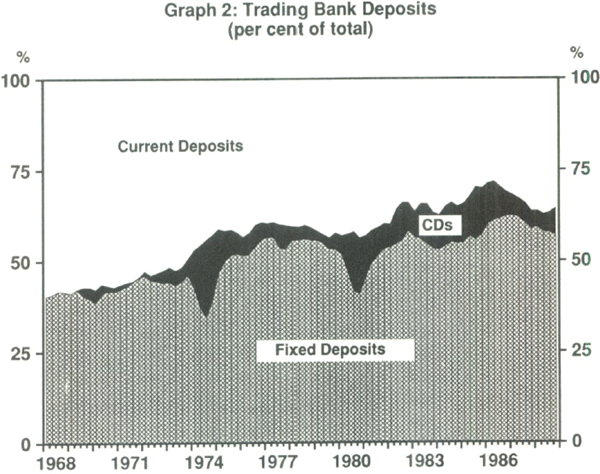
With greater freedom to set interest rates on deposits, banks moved towards liability management. This is illustrated in Graph 3 which shows the same series as Graph 1 over the period from 1975 to 1988. The dominance of liability management is most pronounced in the 1980s. The effects of deregulation of bank interest rates is clear from the top panel of the graph. After 1980, rates on fixed deposits moved much more closely in line with bank bill rates. The yield on CDs was virtually identical to that of bank bills. There were no cases after 1980 where bank deposit interest rates were left well behind by movements in other short-term interest rates.
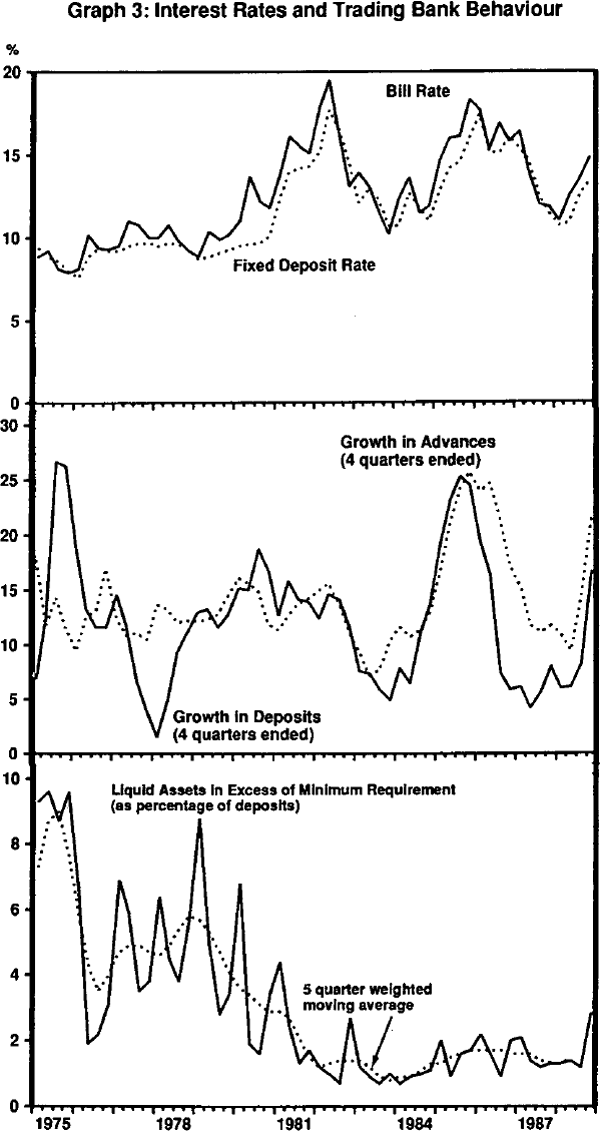
From the second panel, it can be seen that from the late 1970s, the growth rates of bank deposits and advances moved together much more closely than earlier.[5] With controls over interest rates removed, trading banks could manage deposit flows by varying interest rates on CDs and fixed deposits, so as to keep deposits in line with the demand for advances.
The responsiveness of trading bank deposits to a tightening in financial conditions changed after the first half of the 1970s. Whereas in the first half of the 1970s they responded quickly (and well before advances) to a change in interest rates, this was no longer the case in later periods. The policy tightening over 1981/82 is a good example; despite the sharp rise in interest rates, growth of deposits did not slow until lending slowed.
The third panel shows that banks' excess holdings of LGS have been much lower, and much more stable, in the 1980s. With the ability to attract deposits as required, it was no longer necessary, and certainly not profitable, to maintain excess liquid assets as a buffer against a tightening of financial conditions. By the early 1980s, excess holdings were averaging less than 2 per cent of deposits, compared with an average of about 7 per cent in the first half of the 1970s. In the two major tightenings of financial conditions in the first half of the 1980s there was little, if any, change in the excess LGS ratio, whereas the tightenings in the first half of the 1970s produced major falls.
(c) Savings Banks – Continued Asset Management
The experience of savings banks is in sharp contrast to that of trading banks described above.
The structure of savings bank balance sheets remained constrained by regulations for much longer than that of trading banks. Savings banks did not have the outlet provided to trading banks by the certificate of deposit.
Prior to August 1982, savings banks were prohibited from accepting deposits from trading and profit-making bodies and prior to August 1984 could only offer small fixed deposits. These restrictions effectively barred access to wholesale deposits.
Even more importantly, savings banks were restricted in setting deposit rates by the continued regulation of the housing loan rate. The mortgage rate (for loans of less than $100,000 to owner-occupiers) was subject to a ceiling until April 1986, and loans outstanding approved before that date are still subject to that ceiling.
These restrictions meant that savings banks often did not have the freedom to set competitive deposit rates or otherwise significantly influence the inflow of their deposits until comparatively recently. Without this ability, savings bank deposits remained very sensitive to changes in market interest rates. When rates rose, flows of funds into savings banks quickly dried up. By the same token, when market interest rates were falling, savings banks were generally slow in reducing their deposit interest rates, preferring instead to take in deposits to rebuild liquidity.
This is illustrated in Graph 4, which shows the growth of trading bank and savings bank deposits and the 90-day bank bill rate.
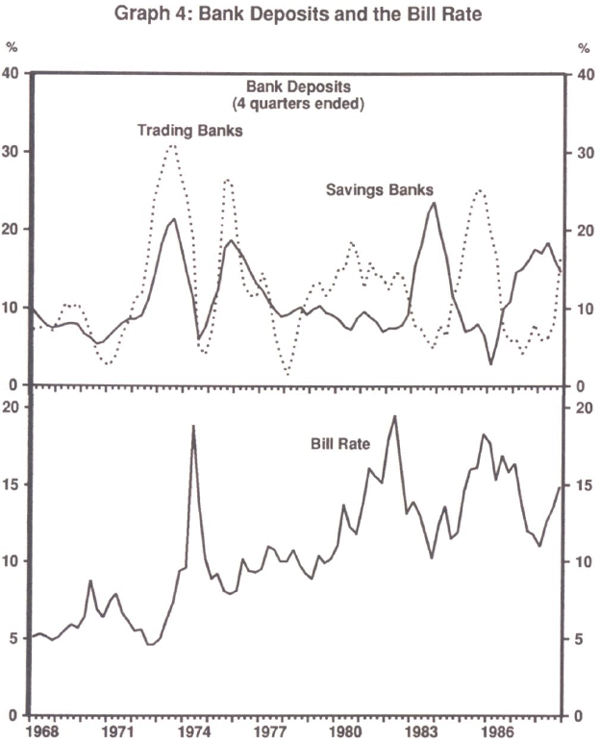
In the first half of the period shown, the experiences of savings banks and trading banks were similar – deposit growth falling when market interest rates rose, and picking up when market rates fell. However, whereas for trading banks this relationship broke down in the 1980s, it persisted for savings banks, with the result that by the early 1980s growth in trading bank and savings bank deposits were following opposite patterns.
For example, as financial conditions tightened in 1984 and 1985, growth of savings bank deposits fell sharply, with funds attracted away by the more aggressive behaviour of trading banks. In the periods of weakening economic activity and falling interest rates in 1983 and 1986, trading bank deposits slowed in line with the growth of their advances, but growth in savings bank deposits picked up.
(d) Implications for Monetary Aggregates
The implications for M3 of these changes in behaviour of trading and savings banks can be seen in Graph 5. It plots annual growth rates of trading bank deposits, savings bank deposits, and M3.
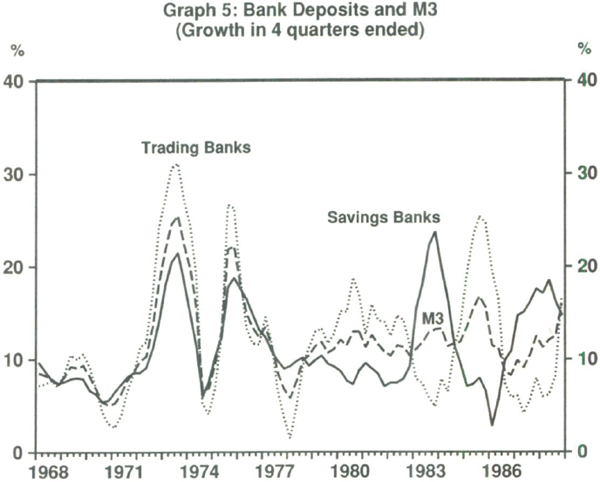
In the early 1970s, all three lines followed roughly the same path. If financial conditions were easy (e.g. as in 1972/73) both savings banks and trading banks experienced large inflows of deposits and growth of M3 increased. When conditions tightened, as they did in 1974 for example, both groups of banks experienced slower growth of deposits and growth of M3 fell.
In this early period, a tightening in monetary policy tended to have a fairly quick and predictable effect on M3. Growth started to fall in the same quarter that interest rates rose. The response of M3 preceded that of lending, with banks initially adjusting by running down their holdings of LGS, and later adjusting loans and advances. This behaviour is consistent with the finding by Bullock, Morris and Stevens (1989) that M3 was a leading indicator of economic activity in this period, while advances were co-incident.
By the early 1980s, the responsiveness of M3 to changes in financial conditions was very much reduced. With trading banks having increased ability to compete for deposits, they were able to maintain inflows until the demand for credit fell. M3 therefore responded to changes in financial conditions only when, and to the extent that, the demand for bank credit did. Its response was therefore both slower and smaller than was the case in the early 1970s, when changes in M3 were related not only to changes in credit but also to changes in holdings of LGS assets.
The responsiveness of M3 was further reduced by the fact that savings bank deposits followed a pattern opposite to that of trading bank deposits. As noted above, this was because savings banks were still constrained by controls on interest rates and were still operating as asset managers. As demand for advances increased, trading banks bid more aggressively for deposits to fund these advances. This did not fully reflect in M3 as some of the deposits were attracted out of savings banks, who were forced to run down their liquidity. Conversely, as demand for advances fell, trading banks slowed their bidding for deposits. Savings banks, however, were willing to accept large inflows to rebuild their liquidity. Again, therefore, the effects on M3 of a slowing in demand for advances was muted.
The experience in 1982/83 provides a good illustration. As noted in Bullock, Morris and Stevens, M3 growth did not slow much during the recession of 1982/83; the annual growth rate was around 12 per cent in 1981 when economic activity peaked, and despite a sharp weakening in output over the following year or two (the most pronounced in the post-war period), growth of M3 slowed only marginally to reach a low of about 10.5 per cent in 1982/83. Throughout this period, growth of M3 generally remained above the targets in place at that time.
The patterns of trading bank and savings bank deposits illustrate why this was so. In 1981, when economic activity was strong, growth in trading bank deposits had been running at an annual rate of about 14 per cent, broadly in line with the growth rate of advances. Then, between mid 1982 and 1983, growth in trading bank advances and deposits slowed noticeably as economic activity weakened.
Savings bank deposits, however, followed a very different pattern. Growth had been quite low in 1981 – around 8 per cent, roughly half the rate of increase in trading bank deposits. Then, during late 1982 and 1983, as the economy slowed and market interest rates fell, growth in savings bank deposits picked up sharply. The annual growth rate reached nearly 25 per cent in late 1983, at a time when growth in trading bank deposits had fallen to 5 per cent.
During the next economic cycle – the strengthening in the economy over 1984 and the weakening over 1986 – trading and savings bank deposits continued to follow opposite patterns, with M3 following a middle course, largely unresponsive to economic conditions.[6]
The interest rate ceiling on savings banks' new housing loans was removed in 1986, and this appears to be starting to have some effect on savings bank behaviour. The end of the distinction between trading and of savings banks could also be expected to change the behaviour of M3.
Aggregates narrower than M3, such as M1, were largely unaffected by this change in trading bank behaviour from asset management to liability management. Because current deposits, which form the bulk of M1, remained largely non-interest bearing until fairly recently, M1 continued to be responsive to changes in interest rates. Bullock, Morris and Stevens noted that M1 had a stable relationship with interest rates up until recently. It has increased faster in recent years than might have been expected on the basis of past relationships. This has coincided with an increase in the proportion of current deposits bearing interest.
This can be seen in Graph 6. The proportion of current deposits bearing interest has risen from a little over 10 per cent in the early 1980s (a figure that had not changed much over the previous 15 years) to 30 per cent in 1987. The trigger for this rise was the removal in August 1984 of regulations restricting the payment of interest on current accounts. Later, an additional factor was the general fall in the level of interest rates over 1987, which tended to encourage the holding of current deposits.
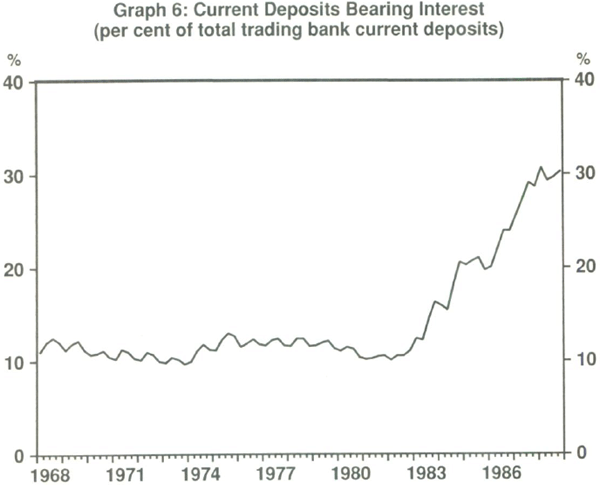
3. The Deregulation of the Early 1980s and Re-Intermediation
There was a further major round of deregulation between 1983 and 1985. The changes included: the removal of interest rate ceilings on overdrafts under $100,000; the removal of the restrictions on savings banks' ability to accept large deposits from profit-making bodies and to offer chequeing facilities; and the abolition of minimum and maximum maturities on savings and trading bank deposits, which allowed banks to enter the market for overnight deposits. In addition, exchange controls were removed, the exchange rate was floated and new banking authorities were granted.
These changes improved the banks' ability to compete in areas where they were already operating and also allowed them to enter areas of business that were previously not available. As a result, banks were able to gain market share at the expense of non-banks – a process often referred to as re-intermediation.
The removal in August 1984 of the restriction that prevented banks from raising deposits of less than 14 days was particularly important in this regard. It led to major changes in the market shares of banks and merchant banks in the overnight money market.
After August 1984, banks built up their overnight deposits substantially. Some of these deposits would have come from the substitution out of longer-term bank deposits but, as the overall size of the market for overnight deposits has expanded only a little faster than the general pace of financial intermediation, this effect looks to have been fairly small. Rather, most of the increase in banks' overnight deposits probably came from the capture of market share from merchant banks.
But while the entry of banks into the overnight market was a clear example of banks gaining at the expense of non-banks, it was only part of the general increase in the competitiveness of banks. Deregulation also affected the relationship between banks and their NBFI subsidiaries. It reduced the incentive for the banks to channel business through the non-bank subsidiaries they had set up to carry out business they could not do themselves. This was particularly the case for banks which had affiliated finance companies, and is likely to have been a factor in the subdued performance of the finance company sector since deregulation, where the four largest corporations are wholly owned by major trading banks.
The overall effects of the many deregulatory changes that took place are difficult to quantify but their significance can be seen in the shift of overall market shares between banks and non-banks that took place around this time.
Until the early 1980s, non-bank borrowing grew much faster than M3. From 1968 to 1982, growth of non-bank borrowings averaged 22 per cent per year, while growth in M3 averaged 12 per cent. However after 1981/82, this difference narrowed sharply.
The effects on market shares can be seen in Graph 7. It shows the percentage of total deposits held by NBFIs and banks, both adjusted and unadjusted for the effects of asset transfers associated with the formation of new banks. During the period 1968 to 1982 the deposit share of banks fell from nearly 80 per cent to about 55 per cent. This trend has since been halted and partly reversed. The increase in the market share of banks in recent years would be greater if measured in terms of credit rather than deposits. This is because banks have been providing credit in ways which did not involve raising deposits, in order to avoid the cost of SRDs (see Section 4 below).
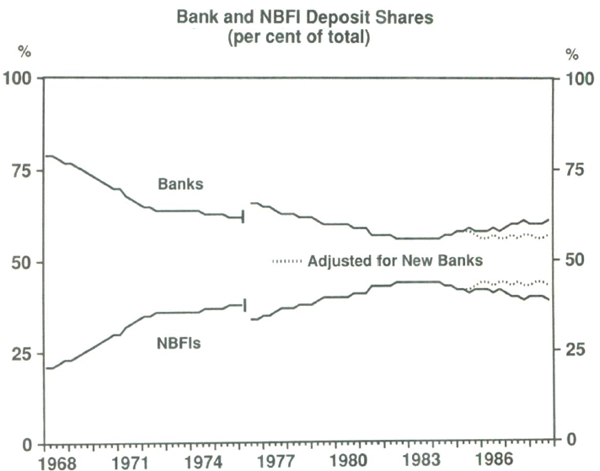
4. Changes to SRD Arrangements
While there were major changes in the behaviour of banks in the early 1980s because of deregulation, some aspects of banks' behaviour continued to be heavily influenced by remaining pockets of regulation. Indeed, deregulation made it easier for banks to modify their behaviour to take account of remaining regulations.
The main aspect of regulation that continued to have a major impact on banks' behaviour was the Statutory Reserve Deposit requirement (SRD). It acted as an incentive for banks to look for forms of funding other than domestic Australian dollar deposits, and to shift away from direct lending and towards fee-for-service activities such as bill acceptance and endorsement. Both these incentives are borne out by the data for recent years which, up to late 1988, showed extremely rapid growth in bank bills on issue and increased funding by banks through foreign currency and offshore liabilities.
These developments had major implications for monetary and financial aggregates. This is illustrated in Graph 8 by referring to the growth in M3 and bank lending. Up to 1984, the two growth rates were largely similar. Thereafter, however, bank lending began to grow much faster than M3 as banks used non-deposit liabilities to fund themselves.
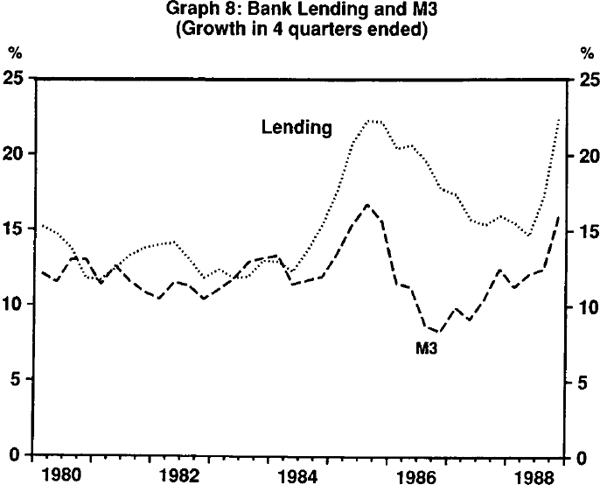
Broader aggregates were also affected, as can be seen in Graph 9 which shows annual growth rates for four financial aggregates: M3; broad money; lending to the private sector by all financial intermediaries (AFI lending); and credit (loans to the private sector by intermediaries plus bank bills outstanding).
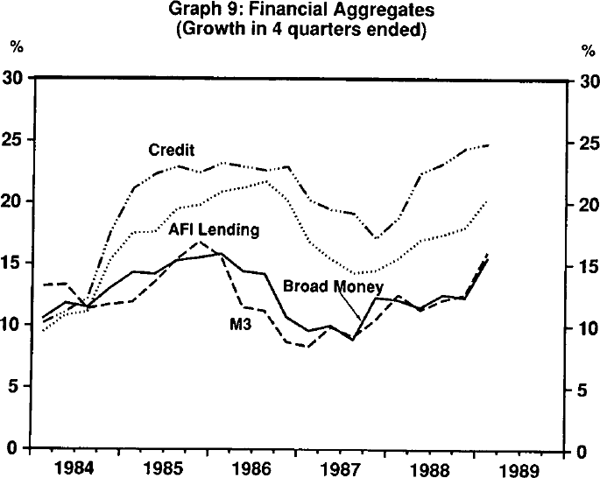
The graph shows that, over the period from 1984 to 1988, the monetary aggregates (M3 and broad money) grew at much lower rates than the lending aggregate which, in turn, grew at a lower rate than credit. Over the four years, AFI lending grew on average 4 percentage points per year faster than broad money, while credit grew a little over 3 percentage points per year faster than AFI lending. The factors behind these disparate growth rates have been discussed in detail in other papers, in particular Macfarlane (1989) and regular Reserve Bank Bulletin articles on financial intermediation. The main ones were that:
- banks met an increasing proportion of the public's needs for finance by securitised loans (bills) rather than funded advances; and
- where banks did fund advances, they used instruments other than Australian dollar deposits (e.g. foreign currency deposits, bank bills, and capital).
The major factor behind these developments was the attempt by banks to avoid the cost of SRDs. By providing finance through bills, which could be on-sold in the market, a bank was able to earn a fee for the service, but avoid the need to fund the loan and therefore meet the cost of SRDs. Where a funded loan was provided, a bank could still avoid the cost of SRDs by funding itself by foreign currency deposits or issuing its own bills. Increases in capital, partly associated with the entry of new banks, also provided funding for advances.
Deregulation and development of financial markets made these processes easier. For example, before 1984 banks were not able to raise foreign currency deposits. Also, the rapid growth of the bank bill market made it easier for banks to provide finance through this means since it enabled them, after discounting a bill, to dispose of it quickly without moving the prices of these securities. The growth of the funds-management industry and the increased sophistication of corporate treasury operations have also provided important avenues for holdings of bills outside the balance sheets of financial intermediaries.
These changes in behaviour mean that conventional lending aggregates, which measure only funded advances, probably understated the amount of finance facilitated by the financial intermediaries. Conventional monetary aggregates, which measure only the extent to which loans are funded through Australian dollar deposits, understated the provision of finance even more so.
These distortions were substantially reduced following the announcement of the winding down of the SRD system in the Treasurer's Budget speech in August 1988. This removed the disincentive to raising domestic deposits. There have been significant changes to the monetary aggregates as a result.
In the December quarter 1988 there was a major re-arrangement in banks' funding patterns, towards domestic deposits and away from offshore funding and bill lines (see Graph 10). This appears to have continued in recent months, though to a lesser extent. As a result of this shift, M3 and broad money have increased at much faster rates than other financial aggregates.
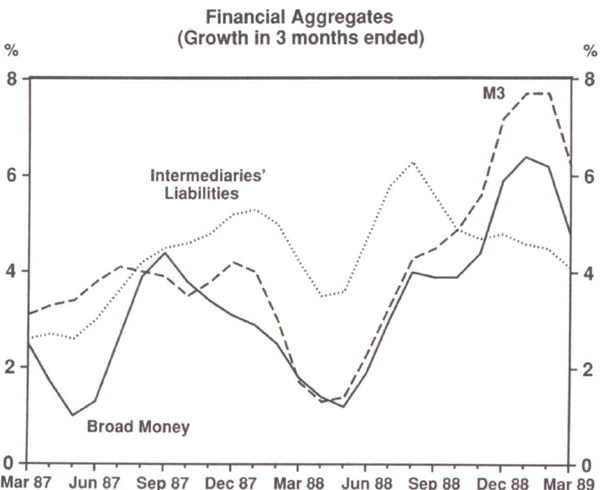
Over time, however, with the winding down of the SRD system, one would expect that the growth rate of monetary aggregates would move into line with that of credit aggregates.
5. Conclusion
Changes in regulations governing banks have allowed a dramatic change in bank behaviour over the past decade. The removal of restrictions on interest rates and maturity of liabilities allowed trading banks to move from being asset managers to being liability managers. The shift initially was gradual following the 1973 deregulation of the CD, but accelerated following the freeing of other bank deposits rates in late 1980, and was largely completed post-1984. For savings banks, this transition started later, as the restrictions on home-loan rates remained in force even after most other restrictions had been lifted.
The move from asset management to liability management has implications for the interpretation of monetary aggregates since, under liability management, the stock of money tends to be demand-determined and a coincident rather than a leading indicator of economic activity. The analysis by Bullock, Morris and Stevens of the relationship between financial aggregates and economic activity over the past two decades showed that M3 did in fact change from being a leading to a coincident indicator.
The change from asset management to liability management also means that monetary aggregates can be subject to large fluctuations in response to shifts in the methods of funding by banks. An example of this was the SRD-induced shift away from conventional deposits to other forms of funding, and the reversal of this following the change to SRD arrangements last September. The relationship between monetary aggregates and economic activity could therefore become unstable, as found by Bullock, Morris and Stevens.
The announced change to SRD arrangements in August 1988 removed a major incentive for banks to avoid funding themselves through conventional deposits, and brought growth in monetary aggregates more into line with that of lending and credit aggregates.
Appendix: Changes to Bank Regulations
This appendix outlines:
- a summary of major regulations affecting banks in 1968;
and
- subsequent significant changes to these regulations.
Regulations in 1968
The powers given to the Reserve Bank (RBA) under the Banking Act (1959) were extensively used to control the activities of the trading and savings banks.
Savings Banks
Savings banks were required to invest:
- 100 per cent of depositors' funds in cash, deposits with the Reserve Bank, deposits with and loans to other banks, securities issued or loans guaranteed by the Commonwealth or a State, securities issued or guaranteed by an authority constituted by or under an Act, housing loans or other loans on the security of land and loans to authorised money market dealers (“specified” assets);
- at least 65 per cent of depositors' funds in cash, Reserve Bank deposits, Commonwealth or State Government securities and securities issued or guaranteed by Commonwealth or State Government authorities (“prescribed” assets); and
- at least 10 per cent of depositors' funds in deposits with the Reserve Bank, Treasury notes and Treasury bills (“liquid” assets).
Savings bank deposit rates were fixed, personal loan rates were subject to the same maximum as trading bank personal loans, and housing loan rates were subject to the maximum rate on trading bank overdrafts. There was a restriction of $10,000 on the maximum interest-bearing amount in any single deposit, and no deposits could be accepted from trading or profit-making bodies.
Trading Banks
Trading banks were subject to the SRD ratio, which required a percentage of Australian dollar deposits to be kept in SRD accounts with the Reserve Bank. The percentage could be varied as a monetary policy tool. The interest payable on these accounts was generally substantially below market rates (and was 0.75 per cent in 1968).[1]
The major trading banks were parties to the LGS convention, which provided for 18 per cent[2] of depositors' balances to be kept in liquid assets, comprising notes and coin and deposits with the Reserve Bank (excluding SRDs), and/or Treasury notes and other Commonwealth Government securities. The other trading banks also had agreements with the RBA to hold certain minimum liquid assets.
Deposits and loans were subject to maximum interest rates and fixed deposits were subject to minimum maturities of 3 months and maximum maturities of 2 years. Banks could accept large fixed deposits (of $100,000 and over) for periods of 30 days to 3 months subject to a maximum rate.
Term and farm loan funds were set up, partly funded by the banks and partly from the SRD accounts. Term loan funds could be used for fixed-term lending to the rural, industrial and commercial fields, and to finance exports. The loans were subject to a minimum term of 3 years and a maximum term of 8 years. Farm development loans were made for development purposes to rural producers and were subject to a maximum term of 15 years.
Quantitative Controls
Since the early 1960s, the RBA had used quantitative controls on bank lending in its monetary policy. Initially, gross new trading bank approvals were subject to RBA guidelines, with net new approvals being subject to controls in later periods. In the late 1970s and early 1980s, growth in trading bank total advances was subject to control.
Major changes since 1968
| 1968 | ||
| May | – | Banks were given approval to undertake lease financing outside the maximum overdraft arrangements. |
| 1969 | ||
| March | – | Approval was given for banks to issue certificates of deposit over term of three months to two years, for amounts over $50,000, subject to a maximum interest rate. |
| – | Savings banks were allowed to introduce progressive savings accounts at interest rates up to 1 per cent higher than ordinary deposit accounts. The maximum amount on which interest could be paid was set at $10,000. | |
| December | – | Savings banks were allowed to offer investment accounts, subject to a minimum balance of $500, minimum transactions of $100, three months notice of withdrawal, and a maximum interest rate. |
| 1970 | ||
| March | – | Savings bank deposit rates could be varied subject to the maximum rate set by the Reserve Bank. |
| April | – | The maximum interest-bearing amount in any single savings bank account was increased from $10,000 to $20,000. |
| October | – | The savings bank prescribed asset ratio was reduced from 65 per cent to 60 per cent. |
| December | – | The maximum term on trading bank fixed deposits was increased from two to four years. |
| 1971 | ||
| August | – | The minimum balance on savings bank investment accounts was reduced from $500 to $100 and the minimum transaction requirement was dropped. |
| 1972 | ||
| February | – | The maximum interest rate on overdrafts and housing loans over $50,000 was removed, and interest rates on these larger loans became a matter for negotiation between banks and their customers. |
| – | Trading banks were given increased freedom to negotiate interest rates on deposits greater than $50,000, subject to a maximum rate, for terms between 30 days and four years. | |
| 1973 | ||
| April | – | The interest-bearing limit on savings bank investment accounts was lifted from $20,000 to $50,000. |
| September | – | The interest rate ceiling on certificates of deposit was removed, and the maximum term was extended from two to four years. |
| 1974 | ||
| March | – | The interest-bearing limit on savings bank ordinary and investment accounts was lifted, and the 3-month notice requirement replaced by one month's notice, after a 3-month minimum term. |
| September | – | The savings bank prescribed asset ratio was reduced to 50 per cent, and the liquid assets ratio cut to 7.5 per cent. |
| 1975 | ||
| January | – | The agreement between banks to maintain a uniform fee structure was discontinued, as it was contrary to the Trade Practices Act. |
| 1976 | ||
| February | – | The maximum overdraft and housing loan interest rates were extended to loans drawn under limits of less than $100,000. |
| November | – | The interest rate payable on SRDs was increased to 2.5 per cent. |
| 1977 | ||
| May | – | The savings bank prescribed asset ratio was reduced to 45 per cent. |
| 1978 | ||
| August | – | The savings bank prescribed asset ratio was reduced to 40 per cent. |
| September | – | The maximum maturity for trading banks' term loans was increased to 10 years. |
| October | – | The three-month initial notice requirement on savings bank investment accounts was reduced to one month, and the minimum balance requirement was removed. |
| 1980 | ||
| February | – | Savings bank statement accounts were introduced. |
| May | – | Banks could apply to the Reserve Bank to increase their equity in money market corporations to a maximum of 60 per cent. |
| December | – | Interest rate ceilings on all trading bank and savings bank deposits were removed. |
| 1981 | ||
| August | – | The minimum term on certificates of deposit was reduced to 30 days. |
| November | – | Trading banks could offer line of credit facilities, comprising a limit to be drawn down at any time with a minimum monthly amount to be repaid; the interest rate to be subject to the maximum applying to personal loans for limits of less than $100,000. |
| 1982 | ||
| March | – | The minimum term on trading bank fixed deposits was reduced from 30 to 14 days for amounts greater than $50,000, and from three months to 30 days for amounts less than $50,000. The minimum term for certificates of deposit was also reduced to 14 days. |
| – | Savings banks were allowed to accept fixed deposits of less than $50,000 for terms between 30 days and 48 months. | |
| – | The requirement of one month's notice of withdrawal on savings bank investment accounts was removed. | |
| May | – | The interest rate payable on SRDs was increased to 5 per cent. |
| June | – | The Reserve Bank announced the ending of quantitative bank lending guidance. |
| August | – | Savings bank specified assets requirement was reduced to 94 per cent to allow a “free choice” tranche of 6 per cent. |
| – | The 40 per cent prescribed asset ratio and the 7.5 per cent liquid assets ratio for savings banks were replaced by the Reserve Assets Ratio (RAR). This ratio required 15 per cent of depositors' balances be held in RBA deposits, CGS and cash. | |
| – | Savings banks were allowed to accept deposits of up to $100,000 from trading or profit making bodies. | |
| 1983 | ||
| December | – | The Australian dollar was floated, and most foreign exchange controls were removed. |
| 1984 | ||
| August | – | All remaining controls on bank deposits removed. This included the removal of minimum and maximum terms on trading and savings bank deposits, and removal of restrictions on the size of savings bank fixed deposits. This allowed banks to compete for overnight funds in the short-term money market. |
| – | Savings banks were permitted to offer chequeing facilities on all accounts, and the $100,000 limit on deposits by a trading or profit making body was removed. | |
| – | The 60 per cent limit on banks' equity in merchant banks was lifted. | |
| September | – | The Treasurer called for applications for new banking authorities. |
| 1985 | ||
| February | – | Sixteen foreign banks were invited to take up banking authorities. |
| April | – | The remaining ceilings on bank interest rates were removed, with the exception of owner-occupied housing loans under $100,000. |
| May | – | The Prime Assets Ratio (PAR) replaced the LGS convention. Twelve per cent of each bank's total liabilities in Australian dollars, (excluding shareholders' funds), within Australia, had to be held in prime assets, comprising notes and coin, balances with the Reserve Bank, Treasury notes and other Commonwealth Government securities, and loans to authorised money market dealers secured against CGS. Funds in SRDs up to 3 per cent of total deposits could also be included as prime assets. |
| November | – | Definition of PAR denominator extended. |
| 1986 | ||
| April | – | The interest rate ceiling on new housing loans was removed. Existing loans remained subject to the previous maximum interest rate of 13.5 per cent. |
| 1987 | ||
| April | – | The savings bank reserve asset ratio was reduced to 13 per cent. |
| 1988 | ||
| August | – | The Reserve Bank issued guidelines for a risk-based measurement of banks' capital adequacy, broadly consistent with the proposals developed by the Bank for International Settlements. |
| – | The Treasurer announced the abolition of the SRD requirement and the removal of the distinction between trading and savings banks. | |
| September | – | From 27 September, the SRD ratio was reduced to zero, and the funds in SRD accounts transferred to “non-callable deposits”. All banks (trading and savings banks) would be required to hold one per cent of their liabilities (excluding shareholders funds) in Australia in the form of non-callable deposits. The excess of the non-callable deposits over the minimum requirement would be returned to banks over a three-year period. |
| – | The distinction between savings and trading banks cannot be totally removed without amendments to legislation. As an interim step, the “free tranche” of savings banks was increased from 6 to 40 per cent effective from 30 September. | |
| – | PAR reduced from 12 to 10 per cent. Banking (Savings Banks) Regulations amended to permit PAR as it applies to trading banks to replace RAR. | |
Footnotes
The authors thank Glenn Stevens, Susan Stewart, Anthony Henry, Bill Russell and Heather Smith for their contributions to this paper. Any errors remain the responsibility of the authors and should not be attributed to the above. [*]
Of course, major changes in holdings of LGS assets usually meant changes in holdings of Commonwealth Government securities (CGS). LGS assets which earnt no interest, such as notes and coin and exchange settlement funds, were always kept to a minimum. [1]
The minimum requirement was set by the “LGS convention”, under which banks agreed to keep not less than a certain proportion of their depositors' funds in the form of LGS assets. [2]
All figures shown in the graphs are quarterly averages. Unless otherwise specified, throughout this paper figures for banks have been adjusted for the establishment of new banks, which may have caused the switching of assets and liabilities from non-bank financial intermediaries (NBFIs) to banks. [3]
The increasing importance of these deposits has been partly reversed in recent years when current deposits of banks have risen sharply (see Section 2(d)). [4]
Over 1986 and 1987, a large gap emerged between the growth of bank deposits and that of bank advances. Rather than being a return to the behaviour of the early 1970s, this was a further refinement of liability management, involving the use of non-deposit liabilities. This is discussed in more detail in Section 4 below. [5]
A mild cycle is apparent in M3 over 1985 and 1986 but, as shown in Section 3 below, part of this would have been due to the increased competitiveness of banks vis-a-vis non-bank intermediaries following effects of further deregulation. [6]
Break in series in 1976. Before 1976, figures for NBFI deposits calculated from annual Financial Flow Accounts data; thereafter from data collected under the Financial Corporations Act. [7]
Figures for M3 in Graph 10 are as published, i.e. not adjusted for the establishment of new banks. [8]
Footnotes Appendix
The SRD ratio was adjusted frequently over the period 1968 to 1981 and ranged between 3 and 10 per cent. The ratio was last used as a tool of monetary policy on 6 January 1981, when it was increased to 7 per cent. Changes to the SRD ratio are set out in Table C.5 in the Reserve Bank Bulletin. [1]
Except between February 1976 and April 1977, when it was 23 per cent. [2]
References
Bullock, M., Morris, D. and Stevens, G. (1989), “The Relationship Between Financial Indicators and Economic Activity: 1968–1987”, this volume, pp 53–85.
Bullock, M., Stevens, G. and Thorp, S. (1988), “Do Financial Aggregates Lead Activity? A Preliminary Analysis”, Reserve Bank of Australia Research Discussion Paper No. 8803, January.
Gramley, L.E. (1982), “Financial Innovation and Monetary Policy”, Federal Reserve Bulletin, July.
Macfarlane, I.J. (1989), “Money, Credit and the Demand for Debt”, Reserve Bank Bulletin, May.
Phillips, J.G. (1971), “Developments in Monetary Theory and Policies”, The Fifth R.C. Mills Memorial Lecture, Sydney University Press, April.
Reserve Bank of Australia (1984), “Monetary Aggregates as Monetary Indicators”, Reserve Bank Bulletin, May.
Reserve Bank of Australia, “Financial Intermediation”, Reserve Bank Bulletin, various.
Stevens, G. and Thorp, S. (1989), “The Relationship Between Financial Indicators and Economic Activity: Some Further Evidence”, this volume, pp 86–123.